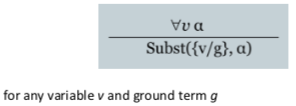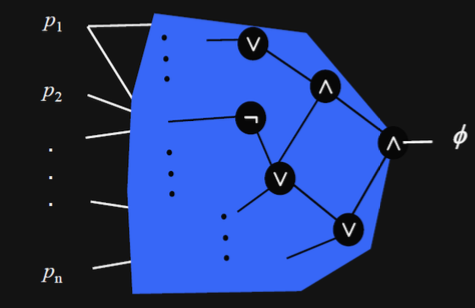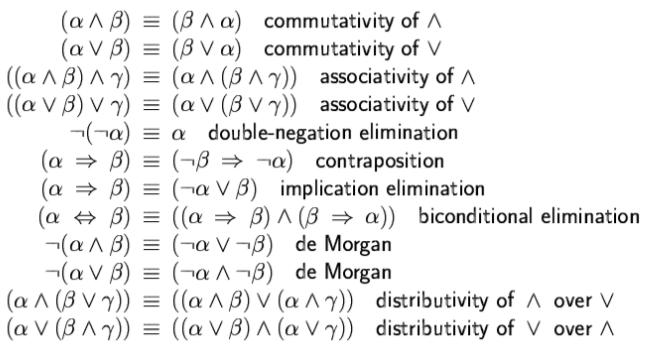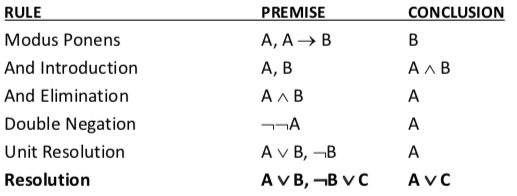Intelligent Systems
Table of Contents
Logical agents
What is logic
logic: generic method to deal with partial/imperfect/implicit information
we need:
- syntax to write statement about rules & knowledge of the game (a language)
- semantics to say what legal expressions mean, the meaning of each sentence with respect to interpretations
- calculus for how to determine meaning for legal expressions
knowledge-based/logical agents must be able to:
- represent states & actions
- incorporate new percepts, update internal representation of world
- deduce hidden properties of the world & appropriate actions
online/exploratory search: go to position, evaluate all options, possibly look ahead. have to re-evaluate current position.
Syntax
Propositional logic (PL)
assumes world contains facts
uses proposition symbols to state these facts.
pros:
- declarative
- allows partial/disjunctive/negated information
- is compositional
- meaning of statements is context-independent
cons:
- very limited expressive power
First order logic (FOL)
an extension of propositional logic.
allows variables to range over atomic symbols in the domain.
assumes world contains:
- objects: people, houses, colors, baseball games, etc.
- relations: red, round, prime, brother of, comes between, bigger than, etc.
- functions: father of, best friend, one more than, plus, etc.
Basic elements:
- Constants: KingJohn, 2, UCB, …
- Predicates: Brother, >, …
- Functions: Sqrt, LeftLegOf, …
- Variables: x, y, …
- Connectives: ∧, ∨, ¬, ⇒, ⇔
Sentences
Atomic sentence = predicate (term_1,..., term_n)
or term_1 = term_2
Term = function(term_1,..., term_n)
or constant
or variable
Complex sentences are made from atomic sentences using connectives.
Quantification
Universal quantification
∀
∀x P is true in a model m iff P is true with x being each possible object in the model
(you can roughly translate that to conjunctions)
typically used with ⇒
CARE: ∀x ∀y ≠ ∀y ∀x
Existential quantification
∃
∃x P is true in a model m iff P is true with x being some possible object in the model
(you can roughly translate that to disjunction of instantiations of P)
typically used with ∧
watch out, if you use it with ⇒, it works even if the LHS is false!
CARE: ∃x ∃y ≠ ∃y ∃x
Quantifier Duality
each quantifier can be expressed in terms of the other
e.g. these are the same:
- ∀x Likes(x, IceCream) – “everyone likes ice cream”
- ¬∃x ¬Likes(x, IceCream) – “there is nobody who doesn’t like ice cream”
Decidability vs undecidability
undecidability
- Turing machine can calculate everything that can be calculated
- halting problem: $K := { (i,x) | \text{program i halts when run on input x})$
decidability
- validity of FOL is not decidable (but semi-decidable)
- if a theorem is logically entailed by an axiom, you can prove that it is.
- if not, you can’t necessarily prove that it’s not (because you can continue with your proof infinitely).
Knowledge engineering in FOL
- Identify the task
- Assemble relevant knowledge
- Decide on vocabulary of predicates, functions, and constants
- Encode general knowledge about the domain (terms that we want to use)
- Encode description of the specific problem instance
- Pose queries to the inference procedure and get answers
Choice of formalisms
first-order logic: represents knowledge
propositional logic: used for reasoning (“propositionalisation”)
then use reasoner to check for entailment of propositional logic knowledge base an decision query
- Davis Putnam (DPLL) algorithm
- formulas have to be in clause normal form (CNF)
- calculus is proof by refutation:
- DPLL determines satisfiability of a KB
- entailment of KB |= a by “refutation”:
- KB |= a if KB ∩ {~a} is unsatisfiable
- assume the opposite and prove it’s impossible
Propositionalising FOL
Reduction to propositional inference
every FOL KB can be propositionalised so as to preserve entailment
if a sentence α is entailed by an FOL KB, it is entailed by a finite subset of the propositionalised KB
Universal instantiation (UI):
every instantiation of a universally quantified sentence is entailed by it.

example:
∀x King(x) ∧ Greedy(x) ⇒ Evil(x)
King(John) ∧ Greedy(John) ⇒ Evil(John)
etc.
Existential instantiation (EI):

example:
∃x Crown(x) ∧ OnHead(x,John)
Crown(C_1) ∧ OnHead(C_1, John)
Applying in Schnapsen - Strategies (examples)
Play Jack
check whether card is a jack:
KB |= PlayJack(x) ?
represent strategy:
∀x PlayJack(x) ⇔ Jack(x)
represent game information:
KB = {Jack(4), Jack(0), Jack(14), Jack(19)}
Play cheap
only play Jacks: check whether card is cheap
KB |= PlayCheap(x) ?
represent strategy:
∀x PlayCheap(x) ⇔ Jack(x) ∨ Queen(x) ∨ King(x)
represent game information:
KB = {Jack(4), Jack(9), Jack(14), Jack(19), Queen(5), ...}
Play trump marriage
TrumpMarriage(x) ⇔ Q(x) & Trump(x) & ∃y: SameColor(x,y) & K(y) & MyCard(y)
SameColor(x,y) ⇔ (C(x) & C(y)) ∨ (D(x) & D(y)) ∨ (H(x) & H(y)) ∨ (S(x) & S(y))
Semantics
Interpretations & Models
interpretation: assignment of meaning to symbols of formal language
model: interpretation that satisfies defining axioms of knowledge base
m is a model of a sentence α if α holds in m.
M(a) is the set of all models of a.
each model specifies true/false for each proposition symbol (∧, ∨, ¬, ⇒, ⇐, ⇔)
Entailment
the knowledge base (KB) entails α: α follows from the information in the knowledge base (KB |= α)
KB entails α iff α holds in all worlds where KB is true.
a knowledge base is the rules + observations.
a sentence is:
- entailed by KB iff α holds in all models of KB
- valid if it is true in all models
- satisfiable if it is true in some model
- unsatisfiable if it is true in no models
two statements are logically equivalent if they are true in same set of models:
α ≡ β iff α |= β and β |= α
Truth
sentences are true with respect to model and interpretation.
model contains objects and relations among them
interpretation specifies referents for:
- constant symbols – objects
- predicate symbols – relations
- function symbols – functional relations
an atomic sentence $predicate(term_1, …, term_n)$ is true iff the objects referred to by $term_1,…, term_n$ are in the relation referred to by $predicate$
Validity
valid if it is true in all models.
e.g. True, A ∨ ¬A, A ⇒ A, (A ∧ (A e.g. True, A ∨ ⇒ B)) ⇒ B)
Satisfiability
- satisfiable if it is true in some model
- unsatisfiable if it is true in no models
Calculus (algorithms for inference)
Properties of inference
sound: if an algorithm $|-$ only derives entailed sentences. i.e. if KB $|-$ α also KB |= α
complete: if an algorithm derives any sentence that is entailed. i.e. KB |= α implies KB |- α
a calculus terminates if it finds entailed sentences in finite time.
a logic is decidable if there is sound and complete calculus that terminates.
Proof methods
- Model checking and search
- truth table enumeration (exponential in n)
- improved backtracking (DPLL)
- heuristics for choosing right order
- application of inference rules
- sound generation of new sentences from old
- proof = sequence of rule applications (actions)
Model checking & search
Truth Tables for inference
enumerate interpretations and check that where KB is true, α is true.
| $fact_1$ | $fact_2$ | $fact_3$ | $KB$ | $α$ |
|---|---|---|---|---|
| false | false | false | false | true |
| false | false | false | false | true |
| false | true | false | true | true |
algorithm:
for (m in truth assignments) {
if (m makes F true) return "satisfiable"
}
return "unsatisfiable"
Effective proofs by model checking
Clever search (depth first, redundancy, heuristics)
Two families of efficient algorithms for propositional inference based on model checking
- complete backtracking search algorithms – DPLL (Davis, Putnam, Logemann, Loveland)
- incomplete local search algorithm (WalkSAT algorithm)
Clause Normal Form (CNF)
memo technique: the C in CNF for conjunction normal form
A PL formula is in CNF if it is a conjunction of disjunctions of literals.
- e.g.: {{a,b}, {~a, c}, {~b, c}}
- equivalent to (a ∨ b) ∧ (~ a ∨ c) ∧ (~ b ∨ c)
calculating CNF:
- Remove implications:
- (p ⇔ q) to ((p ⇒ q) ∧ (q ⇒ p))
- (p → q) to (¬ p ∨ q)
- Move negations inward:
- ¬ (p ∨ q) to (¬ p ∧ ¬ q)
- ¬ (p ∧ q) to (¬ p ∨ ¬ q)
- Move conjunctions outward:
- (r ∨ (p ∧ q)) to ((r ∨ p) ∧ (r ∨ q))
- Split up conjunctive clauses:
- ( (p1 ∨ p2) ∧ (q1 ∨ q2) ) to (p1 ∨ p2), (q1 ∨ q2)
DPLL algorithm
when you have CNF, you can run the DPLL algorithm. determines if propositional logic sentence in CNF is satisfiable.
returns true if F is satisfiable, false otherwise.
basically assign values until contradiction, then backtrack.
Improving DPLL:
- if a literal in a disjunction clause is true, the clause is true
- if a literal in a disjunction clause is false, the literal can be removed
- if a clause is empty, it is false
- a unit literal has to be true
- a pure literal (only appears non-negated) has to be true
the algorithm:
dpll (F, literal) {
remove clauses containing literal
shorten clauses containing ¬literal
if (F contains no clauses)
return true
if (F contains empty clause)
return false
if (F contains a unit or pure literal)
return dpll(F, literal)
choose P in F
if (dpll(F, ¬P))
return true
return dpll(F, P)
}
Heuristic search in DPLL
used in DPLL to select proposition for branching
idea: identify most constrained variable, likely to create many unit clauses
MOM’s heuristic: most occurrences in clauses of minimum length
why is it better than truth table enumeration?
- early termination: clause is true if any literal is true. sentence is false if any clause is false.
- pure symbol heuristic: always appears with the same sign in all clauses, has to be true
- unit clause heuristic: only one literal in the clause, so it must be true
proving entailment KB |= a by refutation:
- translate KB into CNF to get cnf(KB)
- translate ~a into CNF to get cnf(~a)
- add cnf(~a) to cnf(KB)
- apply DPLL until either satisfiable (model is found) or unsatisfiable (search exhausted)
- if satisfiable, not entailed. otherwise, entailed.
Satisfiability modulo theory
Boolean satisfiability (SAT): is there an assignment to the $p_1, p_2, …, p_n$ variables such that $\phi$ evaluates to 1?

SAT vs SMT:
- SMT (satisfiability modulo theories) extend SAT solving by adding extensions.
- SMT solver can solve SAT problem, but not vice-versa.
- SMT is used in analog circuit verification, RTL, verification, and card games.
SMT theories:
- real or integer arithmetic
- equality and uninterpreted functions
- bit vectors and arrays
- properties:
- decidable: an effective procedure exists to determine if formula is member of theory T
- often quantifier-free
- core theory:
- type boolean
- constants {TRUE, FALSE}
- functions {AND, OR, XOR, =>}
- integer theory:
- type int
- all numerals are int constants
- functions {+, -, x, mod, div, abs}
- reals theory:
- type real
- functions {+, -, x, /, <, >}
Rule-based reasoning
Inference rules
inference rule: logical form consisting of function taking premises, analyzing their syntax, and returning one or more conclusions
Modens Ponens: $\frac{\alpha\implies\beta,;\alpha}{\beta}$
And-elimination: $\frac{\alpha\land\beta}{\alpha}$
logical equivalences used as rules: $\frac{\alpha\iff\beta}{(\alpha\implies\beta)\land(\beta\implies\alpha)}$
all logical equivalence rewriting rules:

Searching for proofs
Finding proofs is like finding solutions to search problems.
monotonicity: set of entailed sentences can only increase as info is added to the knowledge base.
- for any sentence α and β,
- if KB |= α, then KB ∧ β |= α
Forward and backward chaining
FC is data-driven, automatic, unconscious:
- derive all facts entailed by the KB
- may do lots of work irrelevant to the goal
BC is goal-driven, appropriate for problem-solving
- specific fact entailed by the KB
- complexity of BC can be much less than linear in size of KB
Resolution
a rule is sound if its conclusion is evaluated to true whenever the premise is evaluated to true.
can be shown to be sound using truth table:

properties resolution:
- resolution rule is sound
- resolution rule is complete (on its own) for formulas in CNF
- resolution can only decide satisfiability
algorithm (again proof by refutation):
- Convert KB ∧ ¬ α into CNF
- Apply resolution rule to resulting clauses
- Continue until: a) no new clauses can be added, hence α does not entail β b) two clauses resolve to entail empty clause, hence α entails β